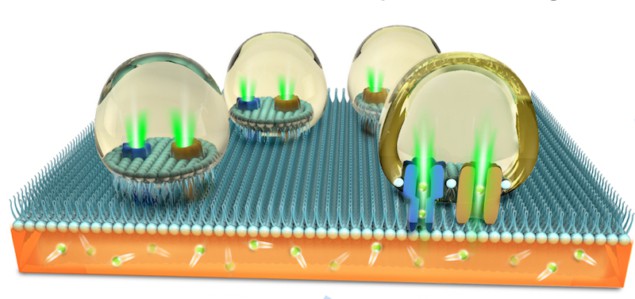
Nanopore sensors can identify a wide variety of single molecules and biomolecules, but all such devices made so far rely on electrodes to measure the current change through the nanopore as a molecule passes through it. Researchers at Nanjing University in China have now made the first nanopore sensor that works optically and does not require any electrical connections. The new technique, dubbed DiffusiOptoPhysiology (DOP), could find applications in drug screening, clinical diagnosis and DNA sequencing.
“Since the first single-molecule nanopore sensors were made a few decades ago, their mode of measurement – which requires a patch clamp amplifier for single-channel recording – has not changed,” explains Shuo Huang, who led this research effort. “This has set a high technical hurdle that has limited nanopore research to a few academic laboratories and specialists around the world.”
Much-simplified technology
“In our work, we were inspired by recent advances in calcium fluorescence imaging,” he says. “The result is a much-simplified technology, the DOP, which is adapted from optical single-channel recording (oSCR).”
oSCR optically monitors calcium ion (Ca2+) flux through individual nanopores embedded in a droplet interface bilayer (DIB). Although very efficient for high-throughput measurements, a pair of electrodes is still required to electrically drive Ca2+ions through the pores. Such a setup is not without risk since manually inserting electrodes into aqueous droplets requires much dexterity and delicate micro-manipulation skills to avoid inadvertently rupturing the DIB.
DOP does not require any electrical connections, explains Huang. It works by optically monitoring (the strong) fluorescence emission that occurs when Ca2+ ions bind with the indicator dye, Fluo-8 (a chemical reagent routinely employed by biologists and chemists) as they diffuse through the channels of a nanopore sensor.
Reporting single molecule activities and parallel measurements
“The fluorescence intensity is proportional to the ionic flux through the channels, which in turn can report single molecule activities, such as binding of small molecules to a nanopore or translocation of nucleic acids through it.”
DOP allows for parallel measurements from thousands of nanopores on a centimetre-sized chip and is cost effective – at less than $1 in consumables for a single measurement. This low cost, as well as its small size makes it highly suitable as a disposable device for use in clinical diagnosis, says Huang.
To test their device, the researchers detected small molecules such as cyclodextrin, PEG1500 and dsDNA as well as various macromolecules and biomacromolecules.

Molecular hopper lines up for DNA sequencing
“Anyone anywhere could carry out DOP”
“The DOP chip may find applications in screening for new drug molecules,” says Huang. “Its low cost and the fact that it is easy to use may allow research teams around the world to now exploit the power of nanopores for potentially routine clinical diagnoses.” Indeed, the Nanjing team says that it has decided to share its technique for preparing biological nanopores via a public gene repository service.
Looking ahead, the researchers say they are now busy working on a highly portable imaging hardware that is compatible with DOP. “This hardware would resemble a mobile cell phone with integrated optical and laser diode-based illumination modules so that anyone anywhere could carry out DOP,” Huang tells Physics World.
The electrode-free nanopore sensor is detailed in Science Advances 10.1126/sciadv.aar3309.



